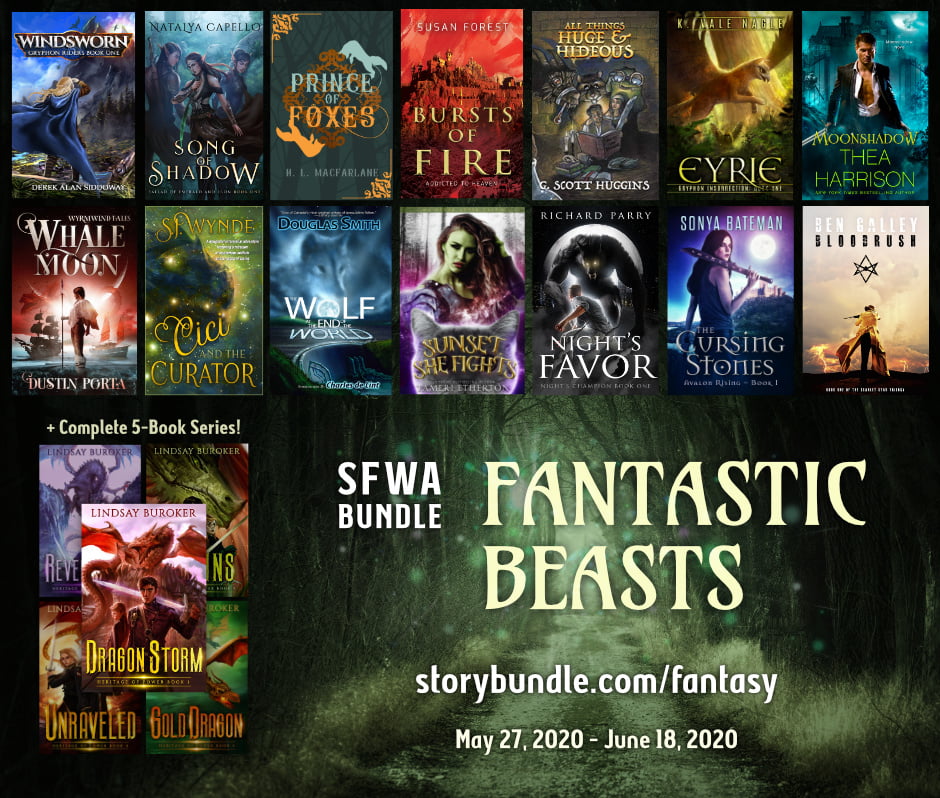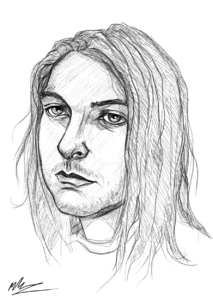 Vale Nagle’s book Eyrie is part of the SFWA Fantastic Beasts storybundle.
Vale Nagle’s book Eyrie is part of the SFWA Fantastic Beasts storybundle.
You can find Vale on the web, @kvalenagle, or Facebook. If you want to do your part for charity and get some ass-kicking books for the price you choose, check out the Fantastic Beasts storybundle. Make sure you check the box for charity!
Q: Pulmonary embolism is a thing I used in a book as a throwaway line, but you’ve *been* there. Who’s fault was it?
A: Oh gosh, that’s a good question. In one sense, the fault for the first embolism was mine. I’d driven to Florida from Colorado, then driven back, and any time you’re doing a long distance card ride, you’re at risk for an embolism. So let that be the first lesson to everyone—if you’re going to be in a car or sitting down for a long period of time, be sure to stand up and move around every two hours!
Really, though, I was one of several people at the same hospital in their late 20s suffering from multiple organ failure due to a pulmonary embolism. Normally, they run a whole clotting panel on you, but because there were so many of us, the doctors just shrugged it off and decided not to.
It took about two years to recover, during which time I went back to university to get a degree in creative writing (I’d done computer science in the past, but I decided that if I’d survived death once, I wanted to get a lot more writing done), picked up kyudo, spent a lot of time at the gym, and just reclaimed my life—at which point the second embolism happened.
If the lesson of the first embolism was to stand up and move around every few hours on trips (or while, say, writing novels), the lesson of the second embolism is that you should have the clotting panel done. A lot of people have some sort of clotting disorder, and nowadays, you can save yourself a lot of heartache by taking one pill a day… if you catch it early.
Life’s pretty exciting now. I’m on enough blood thinners and immunosuppressants that I’m not at risk for more embolisms, but it’s just a matter of fixing the damage, which can take a few years. Insurance in the US is slow-moving, so I’ve been waiting for 11 months now for treatment. While that can sound disheartening, chances are pretty good if you talk to me next year, I’ll probably feel 100% again.
With each new embolism or complication, my doctors upgraded me from “hard to kill” to “increasingly hard to kill,” and I think we’re at “alarmingly hard to kill” at this point, but please don’t take that as a challenge. Be safe, be smart, and hopefully you won’t go through the excitement of multiple organ failure.
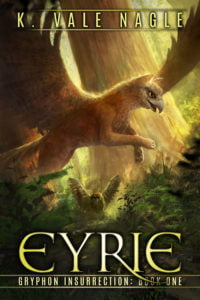 Q: What are three things people don’t know about griffons that might save their life if they met one?
Q: What are three things people don’t know about griffons that might save their life if they met one?
A: Gryphon mythology sprang up in so many disparate cultures that it’s surprising there are commonalities, but pride and vanity are at the top of the list. So if you meet a gryphon, you should definitely tell it what a pretty catbird it is. I suggest starting with something like, “You are a smart and smartly-groomed gryphon, and I think you’re amazing.”
I also don’t know if there’s any historical basis for this, but I think most authors are fairly certain that gryphons enjoy fish. Does that make you more likely to get mauled by gryphons if your pockets are full of salted fish bars? Maybe. But it’s just as likely that tossing a gryphon treat in one direction and running in the other could save your life.
And lastly, knowing obscure animal facts is a lifesaver. Do you see a beautiful orange and black gryphon that you want to hug? Well, you should probably know that the hooded pitohui is a pretty orange and black bird that’s just as toxic as a poison dart frog, so if that’s the bird half, you’re going to want to forego the hugs. And if you’re fleeing through the water, remember that van cats and fishing cats both love water, so presumably, that 10 feet tall pengryphuin with the mismatched eyes and spotted back half and webbed paws likes to swim, too.
You should also remember that penguins are predators. Not for the last example specifically, just for your day-to-day life.
Q: Writing with non-human characters is tricky, and I’m awe-inspired you pulled it off. What was the hardest thing about writing like this? The most rewarding?
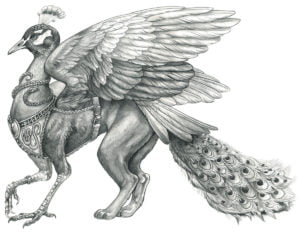 A: There are a few ways to handle non-human characters, and all of them have readers who prefer things written that specific way. Maybe I’m showing my age a little here, but there was a specific period of time right after Jurassic Park released where Robert T. Bakker, the character Dr. Alan Grant (Sam Neil) in the books is based on, was given a book deal to write Raptor Red. His book is set entirely in prehistoric times, follows a Utahraptor named Red who is on the border of sentience and sapience, and has no human characters. It formed one side of the creature fiction spectrum: no humans, all animals, little anthropomorphism (ie, they were animals being animals without human emotions projected upon them).
A: There are a few ways to handle non-human characters, and all of them have readers who prefer things written that specific way. Maybe I’m showing my age a little here, but there was a specific period of time right after Jurassic Park released where Robert T. Bakker, the character Dr. Alan Grant (Sam Neil) in the books is based on, was given a book deal to write Raptor Red. His book is set entirely in prehistoric times, follows a Utahraptor named Red who is on the border of sentience and sapience, and has no human characters. It formed one side of the creature fiction spectrum: no humans, all animals, little anthropomorphism (ie, they were animals being animals without human emotions projected upon them).
At the same time, book stores were pushing The Black Gryphon by Mercedes Lackey and Larry Dixon, the start of a trilogy of novels set in the world of Valdemar with the titular black gryphon, Skandranon, as the protagonist. Skandranon is as smart as a human. Well, he’d say both smarter and prettier. There’s no question, he’s sapient, and his concerns feel relatable. I wouldn’t go so far as to say he’s a human with wings, paws, and a beak, but there’s no resistance going from any of the other 47+ Valdemar books to reading The Black Gryphon. He feels human enough that there’s no problem.
So how do you write a novel that appeals to both fans of Raptor Red and fans of The Black Gryphon? For anyone interested in writing xenofiction, I’d encourage you to find out what appeals to you and write that. For me, I loved both books (and basically the whole creature fantasy, animal fiction, xenofiction genres), so I… well, I suppose I cheated.
I have a full spectrum of gryphons ranging from opinici (think of a gryphon that’s more bird) who can build cities, wear armor, and think on a scholarly level. They’re more like Skandranon in the sense that talons let them use tools. Then I have weald gryphons, more feline, who move towards the animalistic side of the spectrum, but not so far as Red. They should feel relatable but never human. Their tails twitch when they’re excited. Their ears go back when they’re angry. If they’re walking through a field and a moth is atop a reed, they’re going to eat that month. And then probably cough it back up again.
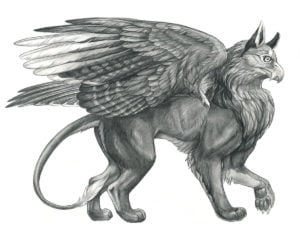 Once I had a baseline for “more human” (opinici) and “more animal, but still very relatable” (weald gryphons) in the first book, I could start to dive deeper in the sequels with gryphons who weren’t as easy to map onto human interests. New opinici were more avian. New gryphons were more feline. The owl gryphons are essentially apex predators. What they really want to do is eat everything. The little sand gryphons aren’t interested in cities or diplomacy. Writing from their point of view, it’s all small cat energy. What can I knock off a ledge or lick? Where’s a good napping place? Seeing them through another character’s point of view, trying to get them to do what you want is like herding cats without a laser pointer.
Once I had a baseline for “more human” (opinici) and “more animal, but still very relatable” (weald gryphons) in the first book, I could start to dive deeper in the sequels with gryphons who weren’t as easy to map onto human interests. New opinici were more avian. New gryphons were more feline. The owl gryphons are essentially apex predators. What they really want to do is eat everything. The little sand gryphons aren’t interested in cities or diplomacy. Writing from their point of view, it’s all small cat energy. What can I knock off a ledge or lick? Where’s a good napping place? Seeing them through another character’s point of view, trying to get them to do what you want is like herding cats without a laser pointer.
I really don’t think there are wrong answers on how you handle creature fiction, only in what audience you’re trying to reach. The only mistake would be not to take advantage of how cool creatures are. Let your dragons breathe fire to solve a problem, let your satyrs headbutt someone off a ledge, let your harpies fly to the top level of a castle only to be foiled by a round doorknob. Go wild!
The most rewarding reason to write creature fantasy is, by far, the fans. I’ve written in other genres, and while you’ll meet people who will mention that they caught one of your stories in a magazine and loved it, I never really saw much fan mail. The moment Eyrie went up for preorder, I had strangers emailing me about how excited they were to see a new novel with a gryphon protagonist. I get people sending me photos of their shelves with Eyrie nestled against a whole hoard of dragon books, gryphon books, and other beautiful covers with mythological creatures on them. I’ve never met a fandom that’s so exciting and supportive of new authors. It’s great!
And now, to turn the question back on you: what do you do to distinguish your vampires and werewolves from your humans? What I like about werewolves specifically is that, from a creature fantasy perspective, there’s enough freedom to either make them a mirror held up to humanity or something completely alien and bestial. And there’s a lot of fun in taking either route.
Q: Wait, what? That’s not how interviews are supposed to work. Well … fine.
What I love about humanity is just how awesome we are when shit is real, you know? Like, we can attempt to murder our neighbours for turning the sprinklers on at 3am, but if sentient alien insects invaded we’d hunker down with them and fight for their children.
I explored what that would look like if we next-leveled it. If werewolves are kinda-sorta us, what does that look like? Are there two sides to our psyche, where one is vicious and murders indiscriminately (you be the judge of whether that’s the werewolf of human side), and the other is intelligent and nurturing? Then I wondered what living with a creature like that inside you for years beyond counting would do to you.
Would the werewolf become more human, or us the beast? That’s what I explore in the Night’s Champion stories. An antagonist in the first book is a werewolf who’s lived for over five thousand years, and is a little … odd, you might say. He murders an entire nightclub and stacks body parts in neat rows. We look at that like he’s some kind of rubs-the-lotion-on-its-skin psychopath, but through the story we learn you won’t become one of them if you’re … properly killed. He kills because he is a beast, but the human in him wants to save others from his curse.
The vampire thing was similar. I wanted to know what would happen if we stayed the same – same memories, same body, same damn haircut – but suddenly needed to feed on the people around us. I’m sure you’ve got a list of some super-annoying people who you’d never get convicted by a jury for murdering, but once you’re out of deserving candidates where do you turn? What if you couldn’t die? What if the hunger made you kill your family?
What would that do to you?
So, that’s how I look at werewolves and vampires vs. us. All the things we feel, but lensed over eons, laced with suffering, but also love, and hope, and warring with our desires to do the right thing. Worth noting, the Night’s Champion series is not a documentary.
Check out Eyrie in the Fantastic Beasts storybundle:
Discover more from Parrydox
Subscribe to get the latest posts sent to your email.
